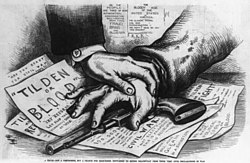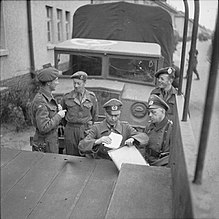Ceasefire
This article has multiple issues. Please help improve it or discuss these issues on the talk page. (Learn how and when to remove these messages)
|

By Thomas Nast in Harper's Weekly, February 17, 1877, p. 132.
A ceasefire (or truce), also called cease fire, is a temporary stoppage of a war in which each side agrees with the other to suspend aggressive actions. Ceasefires may be declared as part of a formal treaty, but they have also been called as part of an informal understanding between opposing forces. A ceasefire is usually more limited than a broader armistice, which is a formal agreement to end fighting. Successful ceasefires may be followed by armistices, and finally by peace treaties.
Historical examples
World War I
During World War I, on December 24, 1914, there was an unofficial ceasefire on the Western Front as France, the United Kingdom, and Germany observed Christmas. There are accounts that claimed the unofficial ceasefire took place through the week leading to Christmas and British and German troops exchanged seasonal greetings and songs between their trenches.[1] It was brief but spontaneous, beginning when German soldiers lit Christmas trees, and it quickly spread up and down the Western Front.[2] One account described this development in the following words:
It was good to see the human spirit prevailed amongst all sides at the front, the sharing and fraternity. All was well until the higher echelons of command got to hear about the effect of the ceasefire, whereby their wrath ensured a return to hostilities.[3]
There was no treaty signed during this Christmas truce and the war resumed after a few days.

Korean War
On November 29, 1952, the newly U.S. president-elect Dwight D. Eisenhower, went to Korea to learn what might end the Korean War. With the United Nations' acceptance of India's proposed Korean War armistice, the Korean People's Army (KPA), the People's Volunteer Army (PVA), and the UN Command ceased fire with the battle line approximately at the 38th parallel. Upon agreeing to the ceasefire agreement, the belligerents established the Korean Demilitarized Zone (DMZ), which has since been patrolled by the KPA and the joint ROKA, US, and UN Command. The Korean Demilitarized Zone runs northeast of the 38th parallel; to the south, it travels west. The old Korean capital city of Kaesong, site of the armistice negotiations, originally lay in the pre-war ROK, but now is in the DPRK. The United Nations Command (supported by the United States), the North Korean Korean People's Army, and the Chinese People's Volunteer Army, signed the Armistice Agreement on July 27, 1953, to end the fighting. The Armistice also called upon the governments of South Korea, North Korea, China, and the United States to participate in continued peace talks. For his part, ROK President Syngman Rhee attacked the peace proceedings. The war is considered to have ended at this point, even though there was no peace treaty.
Vietnam War
On January 15, 1973, President Richard Nixon of the USA ordered a ceasefire of the aerial bombings in North Vietnam. The decision came after Dr. Henry Kissinger, the National Security Affairs advisor to the president, returned to Washington from Paris, France with a draft peace proposal. Combat missions continued in South Vietnam. By January 27, 1973, all warring parties in the Vietnam War signed a ceasefire as a prelude to the Paris Peace Accord.
Persian Gulf War
After Iraq was driven by U.S.-led coalition forces out of Kuwait during Operation Desert Storm, Iraq and the U.N. Security Council signed a ceasefire agreement on March 3, 1991. Throughout the 1990s, the U.N. Security Council passed 16 Resolutions calling for Iraq to disarm the WMDs program unconditionally and immediately. Because no peace treaty was signed after the Gulf War, the war still remained in effect, such as an assassination attempt of former U.S. President George H. W. Bush by Iraqi agents while on a visit to Kuwait and Iraq was bombed in June 1993 as a response, Iraqi forces firing on coalition aircraft patrolling the Iraqi no-fly zones, U.S. President Bill Clinton's bombing of Baghdad in 1998 during Operation Desert Fox, and an earlier 1996 bombing of Iraq by the U.S. during Operation Desert Strike. The war remained in effect until 2003 when U.S. and United Kingdom forces invaded Iraq and toppled Saddam Hussein's regime from power.
Kashmir conflict
A United Nations-mediated ceasefire was agreed between India and Pakistan on 1 January 1949, ending the Indo-Pakistani War of 1947 (also called the `1947 Kashmir War'). Fighting broke out between the two newly independent countries in Kashmir in October 1947, with India intervening on behalf of the princely ruler of Kashmir who had joined India and the rebels, who were supported by Pakistan. The fighting was limited to Kashmir but, apprehensive that it might develop into a full-scale international war, India referred the matter to the UN Security Council under Article 35 of the UN Charter, which addresses situations `likely to endanger the maintenance of international peace'. The Security Council set up a dedicated United Nations Commission for India and Pakistan, which mediated for an entire year as the fighting continued. After several UN resolutions outlining a procedure for resolving the dispute via a plebiscite, a ceasefire agreement was reached between the countries towards the end of December 1948, which came into effect in the New Year. The Security Council set up a United Nations Military Observer Group for India and Pakistan (UNMOGIP) to monitor the ceasefire line.[4] India has declared a ceasefire in Kashmir Valley during Ramadan 2018.[5]
Betrayal of the Assyrians during ceasefire
During World War I, Turkey, which was an ally of Germany, had its troops stationed both in the Balkan States in the west and at the Russian-Iranian border in the north and east. The Russian army was holding its positions against Turkey in the Caucasus mountains on the north and at the Turkish-Iranian border on the east, but when the Russian army withdrew from the war zone in this area due to Lenin's Revolution, its army stationed in the Caucasus was no longer there to protect the Assyrian and Armenian minorities. The Turkish government, who were angry at the Christians, had been kept under pressure by the Russian Army. In the absence of Russian power in the area, however, the Turkish Army, under the leadership of General Mustafa Kemal Pasha, who later was named Kemal Atatürk, and his close associate Enver Pasha, had some time to reconsolidate their positions on the two eastern borders.
In the meantime, the Kurdish chieftain Simko Shikak was secretly working with both the Turkish and Iranian governments for the annihilation of the Assyrians. Simko's hope[citation needed] was that by annihilating the Assyrians he would get an autonomous rule for his people, who lived in both Turkey and Iran. Simko requested a summit meeting for peace with Shimun XIX Benyamin, who was at the time both top religious leader of the Assyrian Church of the East and political leader of the Assyrians. Shimun accepted Simko's invitation for a peace mission, and took on March 3, 1918, an entourage after approximately 150 well armed men with him, because Simko was known[citation needed] to be untrustworthy. As the carriage carrying Shimun reached Simko headquarters, he was greeted by Simko's guards. As Shimun approached the interior of Simko's inner quarters, the Kurdish leader received him with all honour. The two leaders' discussions were amicable. One of Shimun's men had observed the shadows of some men on the very large roof of the headquarters, not realizing that there were actually several hundred of Simko's armed men hiding on the rooftop and all around the buildings. Simko later escorted Shimun to the gate, kissed his hand, and his horsemen were ready to conduct him on his way. When Shimun and his entourage stepped outside of the yard, Simko's men opened fire, killing the religious leader and about 140 of his men. Of the ten men who escaped, six were wounded.
The Assyrians, who were now left without both a political and a religious leader, fled their homes and villages while being persecuted by the Turks of the Ottoman empire and the Kurds.
Israeli–Palestinian conflict
An example of a ceasefire in the Israeli–Palestinian conflict was announced between Israel and the Palestinian National Authority on February 8, 2005. When announced, chief Palestinian negotiator Saeb Erekat publicly defined the ceasefire as follows: "We have agreed that today President Mahmoud Abbas will declare a full cessation of violence against Israelis anywhere and Prime Minister Ariel Sharon will declare a full cessation of violence and military activities against Palestinians anywhere."[6]
Provisional IRA – British government
Throughout the period of The Troubles, the Provisional IRA and other paramilitary groups have called ceasefires. The most notable of these being the IRA ceasefire which was called on August 31, 1994, and ended on February 9, 1996, with the Docklands bombing. Another ceasefire was declared in July 1997 after negotiations were reopened.
The IRA traditionally called a Christmas truce.[7]
Spanish government – ETA
ETA has declared several ceasefires during its long running campaign against the Spanish state. A ceasefire declared in March 2006, was broken on December 30, 2006, when a car bomb exploded in Madrid killing two people.[8] On 5 September 2010 ETA declared a ceasefire.[9]
Syrian Civil War
Several attempts have been made to broker ceasefires in the Syrian Civil War.[10]
See also
References
- ^ Evans, Abigail; Bartollas, Clemens; Graham, Gordon; Henke, Kenneth (2011). The Long Shadow of Emile Cailliet: Faith, Philosophy, and Theological Education. Eugene, OR: Wipf and Stock Publishers. ISBN 9781610971126.
- ^ Brockell, Gillian (December 24, 2017). "The Christmas Truce miracle: Soldiers put down their guns to sing carols and drink wine". Washington Post. Retrieved 2018-08-27.
{{cite web}}: Cite has empty unknown parameter:|dead-url=(help) - ^ Wilson, Ross (2016). Cultural Heritage of the Great War in Britain. Oxon: Routledge. p. 74. ISBN 9781409445739.
- ^ Schofield, Victoria (2003) [First published in 2000], Kashmir in Conflict, London and New York: I. B. Taurus & Co, pp. 68–69, ISBN 1860648983
- ^ "India declares ceasefire in Kashmir - Global Village Space". Global Village Space. 2018-05-17. Retrieved 2018-05-18.
- ^ Wedeman, Ben; Raz, Guy; Koppel, Andrea (2005-02-07). "Mideast cease-fire expected Tuesday". CNN. Retrieved 2007-01-03.
- ^ "IRA Declares Usual Christmas Truce". Los Angeles Times. December 24, 1993.
- ^ Second Madrid blast victim found
- ^ Spain's ETA 'declares ceasefire'
- ^ Lundgren, Magnus (2016). "Mediation in Syria: initiatives, strategies, and obstacles, 2011–2016". Contemporary Security Policy. 37: 273–288.
